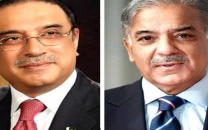Audiences have progressed, dramas have not
In a landscape teeming with options, the entertainment tastes of Pakistani youth are changing

Considering our country’s status as the fifth largest young country in the world with 64% of the country's population below the age of 30, one would expect the media to be brimming with fresh ideas and youthful spirit reflected in all spheres of society. But unfortunately, the youth appear to be missing in most spheres including the mass media. As the years have progressed, sadly, there has been a significant decline in youth-relevant television shows and dramas.
Up until early 2010, several television channels aired dramas such as Shashlik, Satrangi, and Chemistry that centred on younger individuals, their educational lives, and friendships. A range of reality shows including singing competitions and game shows with young contestants were also broadcasted during this time. Some channels launched alternative channels that aimed to cater to young audiences by featuring pop culture and music. Perhaps, these efforts were inspired by the early 2000s’ booming pop culture in the West, particularly the US. Nonetheless, at the time, the Pakistani youth was somewhat satisfied with the mass media. Social media had happened yet, nor were OTTs born.
It is difficult to pinpoint exactly when youth-centric content disappeared from our screens, but perhaps, it was a gradual process. Presently, there are few television dramas and programmes that are specifically made for the youth. Certainly, many primetime dramas feature young faces, but the themes and tropes are largely domestic and matrimonial. Even though these are relevant societal issues, but many other sociocultural issues are entirely absent from the scripts.
Our burgeoning youth population, which is ever-so-present on social media, has not shied away from expressing its disdain for the entertainment industry and its tilt towards monotonous scripts and storylines. In fact, in the recent years, several dramas such as Meray Paas Tum Ho, Habs, Kaisi Teri Khudgarzi, and more recently Tere Bin received severe backlash from the youth over problematic characters and storylines.
Recently, in the quest to find out what young Pakistani audiences think of our dramas, I conducted some personal interviews, and an informal survey through Google form, Twitter and Facebook and reached out to Pakistani youth living abroad as well as in Karachi, Hyderabad, Lahore, Faisalabad, Rawalpindi-Islamabad and Peshawar.
Foreign ka maal!
A large number of respondents between the ages of 16 to 28 claimed to prefer foreign content as they find it more relatable, relevant, and entertaining. This inclination has only grown with the advent of global streaming services such as Netflix, Amazon Prime, and HBO. “Streaming services might have ruined Pakistani dramas for me,” says Hira, 22, a final-year university student from Karachi. I watch K-dramas and even though, they can be long and the stories are quite basic at times, the depiction is interesting. On the other hand, Pakistani dramas are full of constant crying and whinging in a love triangle involving two girls and one guy or vice versa along with some evil in-laws.”
On the other hand, a large proportion of the youth finds Pakistani dramas difficult to connect with and storylines repetitive, whereas they believe that foreign content available now is much easier to consume or better still “binge-worthy”.
A number of respondents are willing to endure the trials and tribulations of using free, illegal streaming sites that offer a wider range of content.
Short and sweet
Many have also alternated television with apps such as TikTok and Instagram. Samina, 28, who works as domestic help, does not post on TikTok or Instagram, but enjoys watching reels and videos on the two apps as she finds them more entertaining and less time-consuming. She feels that it is difficult to keep up with Pakistani dramas and doesn’t find them all that entertaining. “With TikTok, I do not have to commit to anything and if I don’t like, I can simply scroll up,” she says.
Some of the respondents based in various cities of Pakistan and others living abroad claim that they still watch Pakistani dramas because they are relatable and keep them connected with their culture and values. The free and easy access to dramas through either TV or YouTube makes it a preferable choice. In rural and remote regions where WiFi services are largely inaccessible and unaffordable, watching television dramas often becomes a communal activity. Some people download episodes on their phones if and when they have 3G or 4G services to watch later.
No more marriage issues please
Young audiences say that almost all dramas appear similar because storylines are constantly circling marriages and tussles between in-laws.
Young viewers prefer dramas with a strong cast and good scripts, especially those that focus on issues other than marriage and saas-bahu squabbles. When asked about what dramas they enjoyed watching recently, Kuch Ankahi and Fairy Tale were the popular choices and interestingly, neither drama was solely dedicated to marriage, but highlighted several issues, and remained light-hearted and humorous. Other favourites include Udaari, Dastaan, Yakeen Ka Safar, Baaghi, Ghisi Pitti Muhabbat and Ramadan specials, such as Suno Chanda.
Give toxic, get toxic/A toxic exchange
A large number of young women agreed that the overarching theme in most dramas today is toxic and abusive marriages. Given that television plays a critical role in shaping people’s attitudes and behaviours, younger viewers who are still in school, college or university feel that the dramas are contributing to rigid patriarchal mindsets and structures.
Regressive, old-school ideas
The dramas lack diversity in terms of languages, characters, and subplots. Most dramas are based in Karachi and only depict a certain type of urban lifestyle. They seldom feature other parts of the country and often struggle with accurate portrayal promulgating racial stereotypes.
This has further alienated the younger audiences who believe that scriptwriters do not conduct proper research or connect with people from different regions and provinces. Inaccurate portrayals have far-reaching implications as viewers often succumb to stereotypes and adopt discriminatory attitudes in real life. Thus, the youth would rather distance themselves from such content than watch it or identify with it.
Often, female characters in Western attire are the antagonists, whilst the protagonists wear traditional clothes. Viewers think it is rather shallow to limit characters to their clothing.
Damsels in distress are history
Young women are particularly disappointed by the constant portrayal of women as damsels in distress waiting to be rescued by a man. They believe that this impedes women’s progress and reinforces sexist ideas. Most female characters lack determination, decisiveness, while empowered or career-oriented women are usually portrayed in a negative light. Instead, the primary focus is on marriage, which is intertwined with harmful misogynistic, and regressive ideas. By the time an episode ends, the viewer feels more distressed than entertained.
Let’s move forward
Everyone is cognisant of the entertainment industry’s constraints, but that does not mean that the narratives cannot and should not change. No one expects radical changes, but scriptwriters and producers should widen the scope of narratives by shifting focus on a range of genres. Perhaps young writers, associate producers, and other filming staff can help change perspectives.
Directors, producers, and scriptwriters often argue that they write and produce dramas that sell. Anyone who follows Pakistani dramas regularly is well-aware that unconventional dramas gain little viewership losing out on significant profits. On the other hand, the youth feel that they rarely see unconventional dramas on mainstream channels and the promos are not convincing enough for them to tune into the channel every week.
Perhaps, the television industry should consider the youth as active stakeholders in the process and reach out to them through social media to improve communication and reform ideas. It seems that it is not just the stories and scripts that do not appeal to young audiences, but also the graphics, characters, costumes, dialogues, etc.
These are problems that require little effort and can be easily resolved primarily because older dramas did not face the same critique. In fact, many young viewers claimed to have enjoyed watching dramas from the 80s.
Get real and be positive
The majority of our respondents unanimously said that they are not interested in dramas with aggressive, conniving characters and people screaming at each other instead, they want to see realistic stories about changes and issues they experience from adolescence to early adulthood. They want to see real friendships, and empowered individuals with actual careers and their professional challenges. They want to see dramas that do not promote racism, colourism, and elitism but are inclusive of everyone. Dramas where parents support their children’s goals instead of forcing them into marriages.
Dramas should offer comic relief and escapism, but they should also discuss the many issues that are prevalent in society in an informative manner. They should send out a strong positive message that encourages people to except change. Not all dramas should perpetuate unrealistic ideas and standards and but should reflect the daily life and realistic big and small challenges.
Time to introspect
The Pakistani television industry does not necessarily need an overhaul but to introspect, look within and revive older ideas.
Perhaps, they should revisit ‘cult classics’ such as Dhoop Kinare, Tanhaiyaan, Marina Khan’s Baraat series, or more recent dramas such as Sinf-e-Aahan to reinspire themselves. The industry must realise that something has got to give especially considering the rapidly changing demographics of the country. Otherwise, dramas will lose out on a sizeable proportion of the audience to foreign content sooner rather than later.


















COMMENTS
Comments are moderated and generally will be posted if they are on-topic and not abusive.
For more information, please see our Comments FAQ